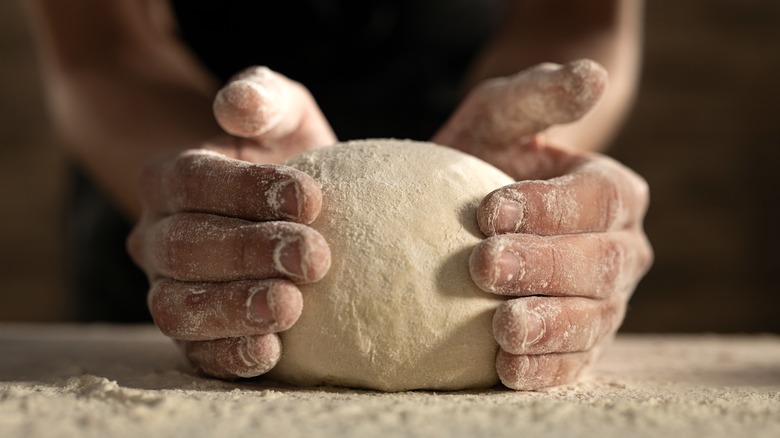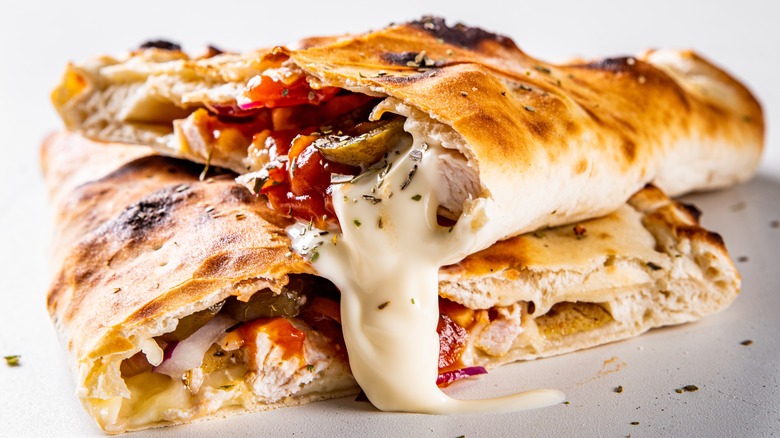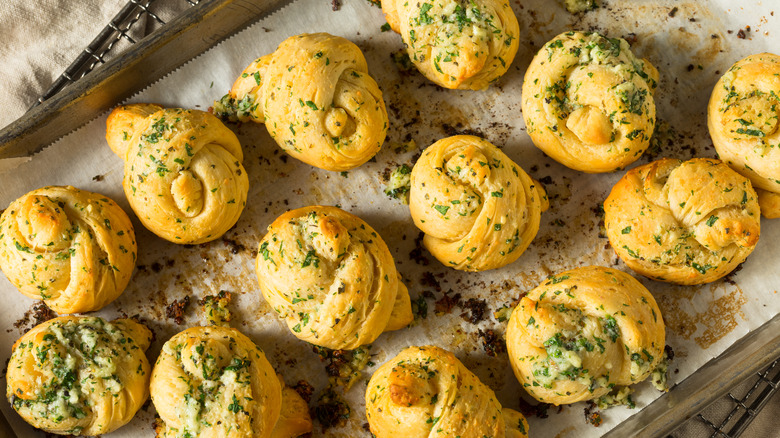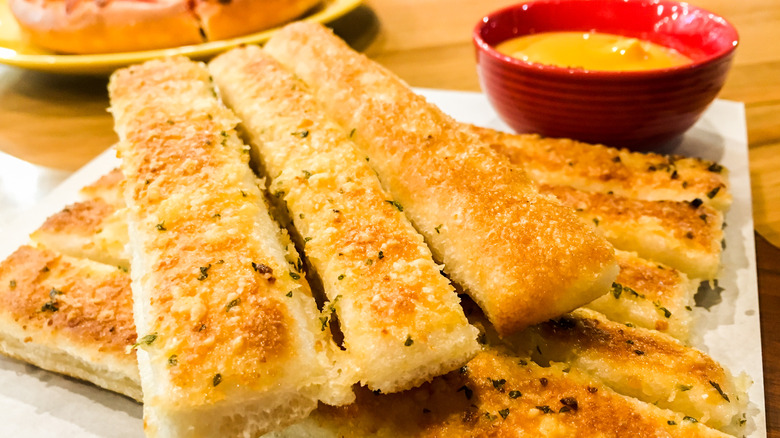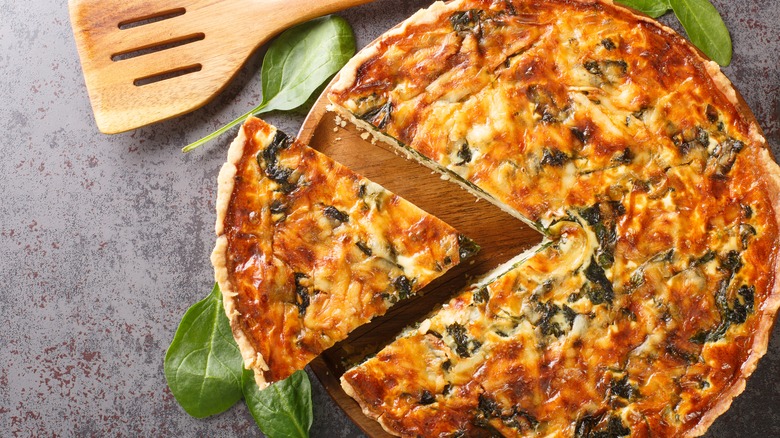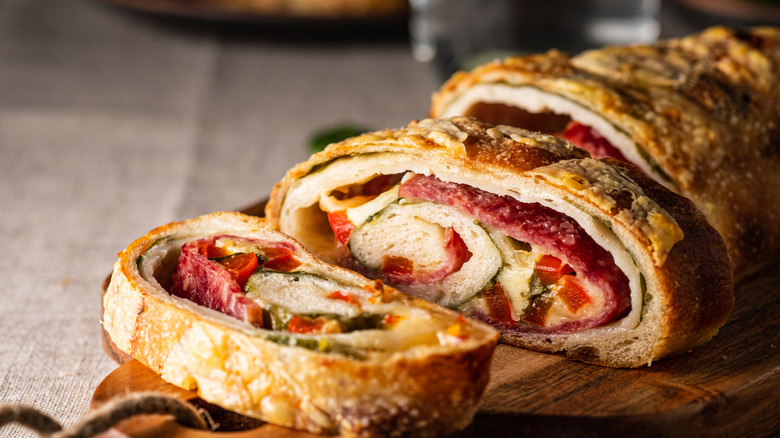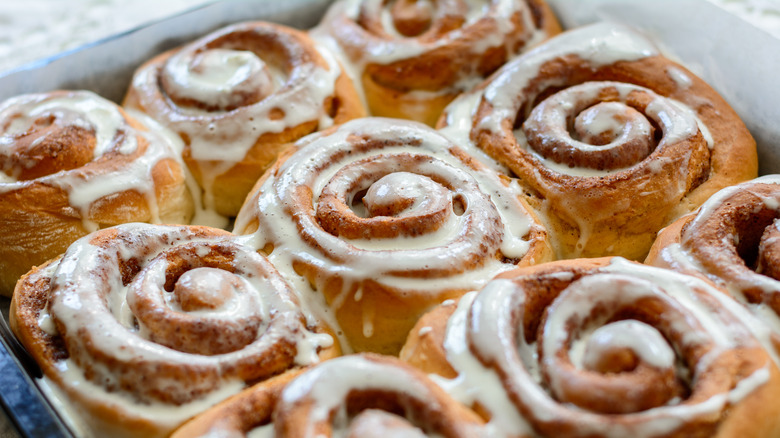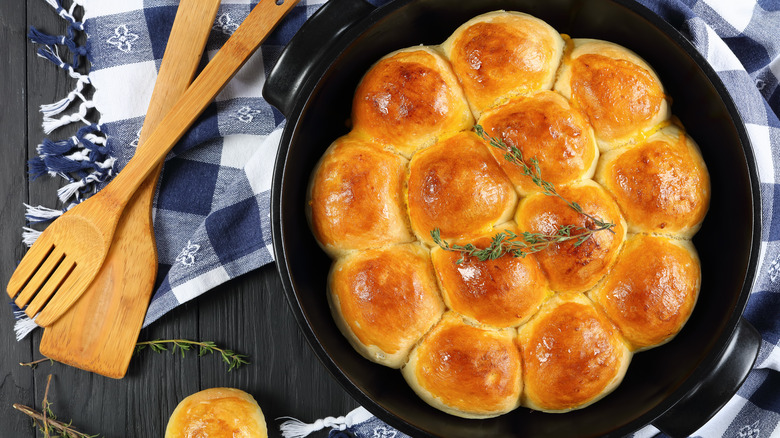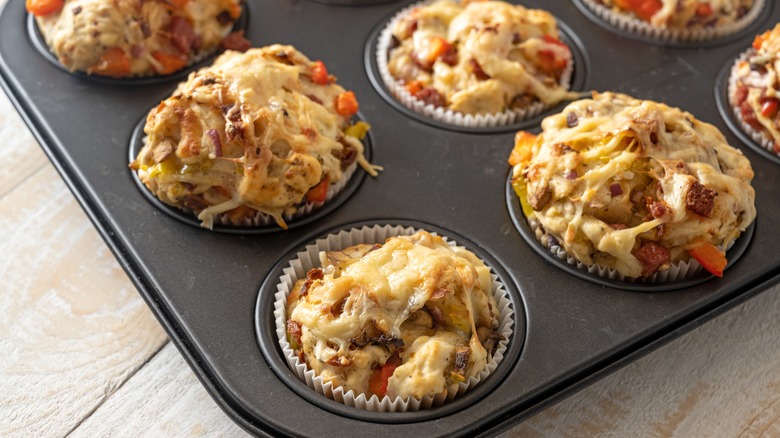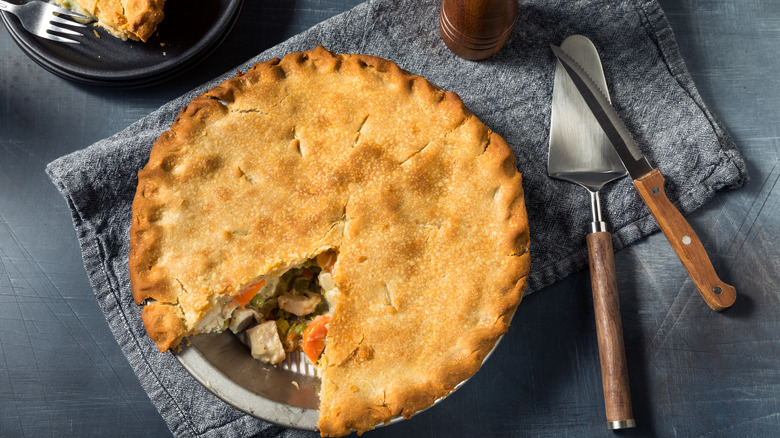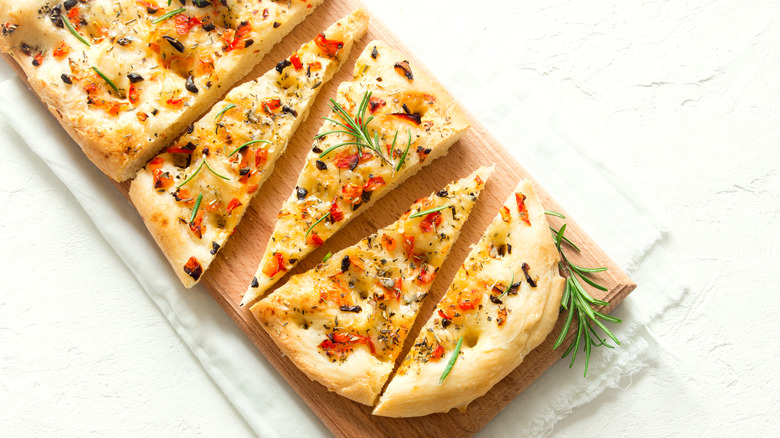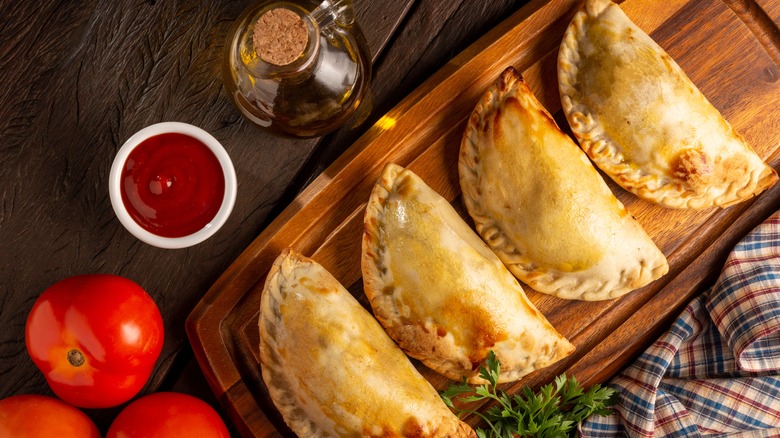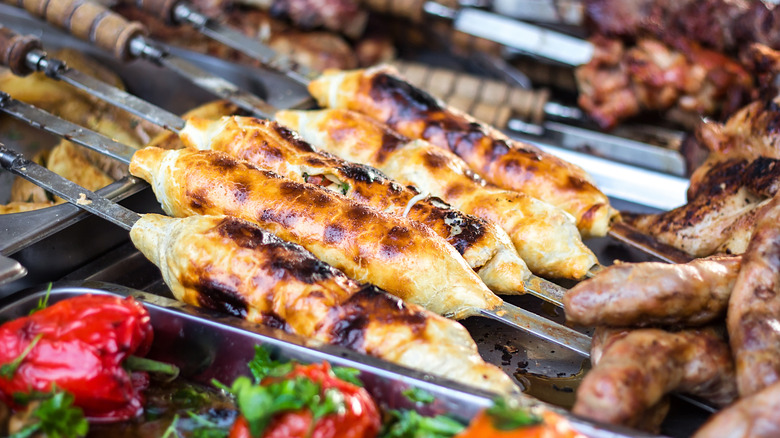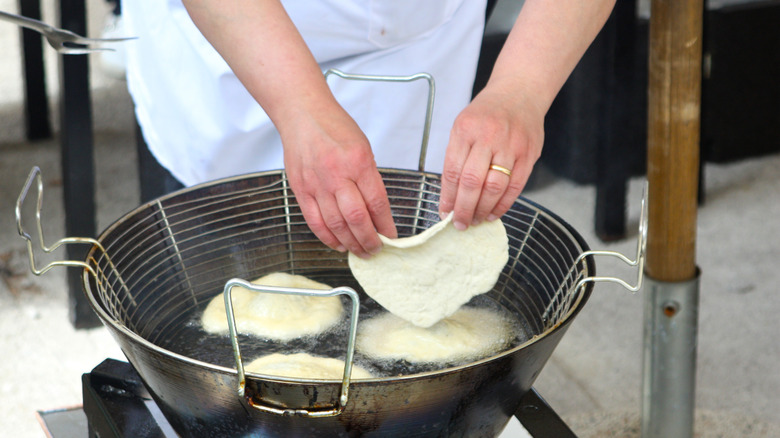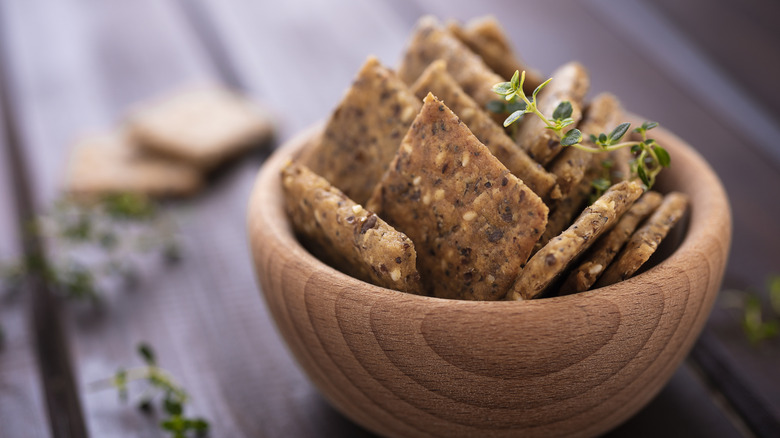14 Popular And Unconventional Uses For Pre-Made Pizza Dough
Pre-made pizza dough is a blank canvas for a creative pizza night. While you certainly can go through the arduous process of making your own homemade pizza crust — which can take several hours with all the rising, proofing, and baking needed — all you need to do with a pre-made dough is plop it out on the countertop and make your own pizza with whatever toppings you have on hand. Since those orbs tend to be sizeable, you may end up with a leftover portion of dough, and thankfully, there are plenty of options to consider beyond pizza.
To answer the question of what you can make with pizza dough, you must first identify the dough's qualities. All doughs are created differently and contain different ingredients, meaning they cannot all be used for the same things. Most conventional pizza doughs that produce a crisp crust and soft inside contain a protein percentage in the mid to low teens and a touch of oil. Pizza dough is also very moist, so it is best for applications where traditional recipes also use the high-hydration dough. With that in mind, here are some of the best ways to take advantage of your leftover pre-made pizza dough for both sweet and savory applications.
Fill them with cheese for calzones
Calzones are like inverted pizzas. Instead of having all the toppings on the top of the pizza, like a pie, the toppings are tucked into the folds of the crust and made into a handheld, portable meal. You can even turn it into a dessert, like our s'mores calzone which is stuffed with heaps of chocolate and gooey marshmallows, but this style is comparatively less common. Instead, most of the options you'll find at Italian restaurants and pizza joints are made savory, like our sausage, kale, and ricotta calzone.
You need to know some essential techniques when making calzones at home. The first is to avoid overstuffing the calzone — you want to ensure you leave an inch or two when you fold it so you can crimp the edges and seal it. You should also poke a few holes in the top of the calzone to let the heat escape. Finally, if you want a perfect golden-brown color on the dough, we recommend brushing it with melted butter or olive oil before baking. If you're making calzones, you should also expect that your pizza dough can make a lot more than you may expect; 1½ pounds of dough makes about four calzones that are about three inches wide.
Get twisty with garlic knots
Garlic knots are a great side dish — and a way to use up the leftover pizza dough you have on hand. To make these twists, you'll need pizza dough, herbs, garlic, and fat (like oil or butter). If you're feeling fancy, you can make cheesy garlic knots with grated Emmentaler or add pepperoni for a unique take on the classic pizza.
The key to making more flavorful homemade garlic knots is to allow the knots to proof twice. The second proof must happen after you roll the dough out into small sections and tie the knots into the desired shape. Once your knots are shaped, you can top them on a tray with your favorite herbs like parsley, garlic, butter, or oil. Then, allow the bready bites to sit for up to four hours, covered lightly on a countertop. Although this resting interval may seem extreme, the extra time will allow the knots to puff up more than if you just slid them right into the oven after shaping and topping them. You'll also find the texture to be much softer and plusher if you rest the dough longer.
Shape them into breadsticks
Breadsticks are like the garlic knot's taller cousin. While you can keep them simple, there are many ways you can spruce up your breadsticks to take them from ordinary to extraordinary. If you want to go with a classic copycat Olive Garden breadstick, flatten the pizza dough until it's about a half-inch thick. Then, cut the strips about an inch wide with a bench scraper or sharp kitchen knife. After the sticks are cut, you'll need to let them proof for another 30 minutes before baking them. To truly make these sticks Olive Garden-style, remember to brush them with a blend of garlic salt, butter, and garlic powder while the breadsticks are warm — but not straight-out-of-the-oven hot.
You can also make breadsticks more exciting by serving them with a dipping sauce. We recommend pairing plain or cheesy breadsticks with a beer cheese dip made with your favorite blend of cheeses; cheddar, blue cheese, and Colby Jack are all options that melt well.
Use the dough for a pie crust
Pie crusts can be notoriously finicky, but you can make your life easier by using pizza crust instead. There are numerous differences between the structure of a pie crust and a pizza crust. Pie crust, also known as a shortbread crust, has flaky layers because of the butter added; pizza dough will come out more tough and bland than a shortbread crust because it has comparatively less fat. If you're making a sweet pie, like apple or blueberry, you should stick to using traditional pie dough (you can buy the pre-made shells, after all). But if you're going savory, you can use pre-made pizza dough instead without hesitation.
One of our favorite savory pies is the eggy brunch classic quiche Lorraine. After you roll out your crust, we recommend blind baking it with an egg wash and a layer of Gruyere at the bottom for a few minutes. Then, add the rest of your bacon, egg, cream, and shallot filling and bake until the temperature reads between 175 and 180 degrees Fahrenheit.
Roll the dough and toppings into a Stromboli
The major difference between a calzone and a Stromboli is that a Stromboli is rectangular in shape and sliced into thin, horizontal pieces for serving. It is also a one-stop-shop for your standard pizza components while calzones often come with a separate dipping sauce — usually marinara.
You'll need your sauce, cheese, and filling to make a Stromboli out of your leftover pizza dough. The most common fillings for a Stromboli are ham, mozzarella, and tomato sauce, but you can get creative and use any combination of toppings you desire. Our recipe for a cheesesteak Stromboli is straight out of Philadelphia — the same city where the Stromboli was created in the 1950s (via Slice Life). This recipe includes hunks of onions, bell peppers, mozzarella, provolone, and sliced sandwich steaks. Once you're ready to assemble, roll out the pizza dough into a rectangle and add your toppings — leaving at least ½ inch of space on each of the sides. Pull the sides in, roll the dough into a log, and seal before baking.
Make an easy version of cinnamon rolls
There's nothing like a warm, toasty cinnamon roll at a Sunday morning brunch. If you have pizza dough left in your fridge from the weekend, you can use it to craft your own cinnamon rolls — and the best part is you'll only need a few additional ingredients. One pound of pizza dough makes about 12 cinnamon rolls, meaning that you can have this recipe ready for a crowd in under an hour.
To make your cinnamon rolls, simply roll your dough out into a large rectangle and cover it with a mixture of melted butter, cinnamon, and sugar. Once the rolls are shaped and sliced, place the rolls into a greased baking pan. You should give the rolls at least an inch of space on all sides to ensure that the rolls cook evenly.
When making these cinnamon rolls, you should try to underbake them slightly because of the texture of the pizza dough which gets crispier than traditional cinnamon roll dough. Pulling them out of the oven early ensures that the rolls are soft and plush. You'll also notice that these rolls are denser and chewier than the standard cinnamon rolls, so the taste and texture might not appeal to all eaters.
Bake cast iron dinner rolls
Dinner rolls are essential to have with Italian food like pasta. So why not use your leftover pizza dough to make a new side for your next meal? We recommend maxing out your proofing time on these rolls after they're shaped to get the fluffiest texture possible. You should also try to cook the rolls in a cast-iron skillet or a greased pie pan, mainly because we think there's something really satisfying about pulling the rolls apart after they're finished baking. A transparent pie plate allows you to check the browning on the bottom of the pan — just make sure the pan is tempered glass that can withstand the oven's heat (between 400 and 425 degrees Fahrenheit).
Once you've rolled your dough into a log, cut it into small pieces and roll those into balls. If you want to improve the flavor of your rolls, we recommend topping them with a fresh herb blend of chopped parsley, basil, and chives, along with butter and flaked sea salt. Then, serve the rolls as-is or with a dipping sauce like homemade marinara.
Grab a muffin tray and make tiny pizzas
If you're a busy parent, you're likely always looking for ways to make dinner portable. If that's the case, muffin tray pizzas made with refrigerated pizza dough should be one of the recipes in your rotation because they are both easy to make and able to be transported to wherever life takes you.
Start making your pizza cups by lining the muffin tins and adding a layer of cooking spray. While you're greasing, you should try to leave your dough out at room temperature — it will make it easier to work with when you need to shape the dough into the bottom and sides of the cups. Next, top each of your cups with layers of cheese, sauce, and toppings, and bake at 400 degrees Fahrenheit for at least ten minutes. If you want to boost the utility of this recipe, you can make these muffin cups a few days ahead of time and place them in your refrigerator or keep them in your freezer for a few months.
Add the dough to the top of pot pie
If you still have pizza dough left after your weekend cinnamon rolls, you should consider using some for your Sunday dinner pot pie. The relatively neutral taste of the crust pairs well with salty ingredients like poultry, peas, carrots, and the soup base in the pie itself.
If you want to keep your pizza dough soft and easy to work with for this recipe, place it in a bowl at room temperature while prepping your other ingredients. If you need to bring your dough up to temperature quicker than that, not to worry. Simply place the dough in a lightly oiled bowl in your oven and heat it at a low temperature — less than 200 degrees Fahrenheit for a few minutes — before leaving it in to do the rest of the preheating in the contained oven. Just avoid the temptation to open the door!
Turn it into flatbread
Flatbreads are super easy to make when you have leftover pizza dough. To make a roti-like flatbread to pair with curry or stew, you can divide room-temperature pizza dough into small balls and then into flat discs. You'll need to spritz the outside of the dough with a bit of water before cooking the flatbread for about two to three minutes on each side. The water causes the dough to develop the characteristic bubbles found on flatbreads like roti and chapati.
You can also use the pizza dough to make a twist on classic Italian focaccia bread. When you're ready to start assembling your focaccia, place the pizza dough in an oiled pan or skillet, dimple it, and coat it with toppings and oil. Like traditional focaccia (which has a dough very similar in texture and hydration to pizza), you should allot about 20 minutes for your dough to proof before baking. This will optimize the flavor and the airiness of the finished bake.
Make empanadas
Pre-made pizza dough has the potential to take us all over the world. Empanadas are originally from Spain but are often seen in cuisines in Latin and Central America. These hand-held meat pies are sliced with 4-inch cutters, so they are significantly smaller than calzones, which are often large enough to be shared among several people. In Spain and Portugal, empanadas are often filled with fish like sardines or cod, chorizo, or pork, cooked in a tomato, garlic, and onion sauce. The empanada can also be made with American and Mexican influence, such as chicken empanadas filled with spicy green chilis, tomatillos, cilantro, Monterey Jack, and queso fresco. These empanadas are served with an avocado corn relish dipping sauce for a fresh contrast to the dense pie.
The significant difference between empanada dough and pizza dough is that empanadas are often made with a corn-based flour called masa harina in addition to or instead of wheat flour. Masa can have a slightly grittier texture than standard wheat, depending on how finely it's ground.
Get crearive with pizza kebabs
Nothing says summer quite like kebabs. Although pizza dough isn't the best for grilling, you can still get in the summer mood and make some pizza kebabs in your oven instead. Pizza kebabs are created by loading your veggies and toppings on a wet wooden skewer (the water helps prevent the wood from burning). Then, cut slices of pizza dough and wrap them around the skewer and the toppings. Next, bake the kebabs until slightly brown before adding a layer of mozzarella cheese and finishing in the oven or on the grill.
We recommend serving your kebabs with pizza sauce for dipping. While you can buy pizza sauce in-store, making your own couldn't be easier. You'll need to simmer tomato paste, tomato sauce, Italian seasonings, and salt and pepper until the sauce thickens. Besides the kebabs, you can use this pizza sauce to make pizza bagels or English muffin pizzas or use it as a dipping sauce for calzones.
Transform it into pizza fritte
Pizza fritta (singular for "fritte") is pizza dough that has been fried and topped with sweet or savory toppings. These tiny discs can be served as an appetizer or dessert depending on how you prepare them. The base recipe is the same whether you go the sweet or savory route. You'll first want to bring your dough up to room temperature before separating it into 3-ounce balls. Then, stretch the dough into discs using your fingers (not a rolling pin since this will deflate the dough and diminish the puffiness once it's fried). Lastly, shallow fry the dough for less than five minutes or until golden brown.
If you want to go the savory route, add fresh prosciutto and mozzarella to the top of the fritta and enjoy. Place the pizza fritte into the oven to melt your toppings. You can also transform your pizza fritte into a sweet treat by adding powdered sugar and cinnamon.
Turn the dough into crunchy crackers
If you entertain frequently, you must have an excellent homemade cracker recipe to serve with your appetizers. You can get the perfect texture for a sheet pan cracker if you thinly roll out pre-made pizza dough without tearing it. If you find the pizza dough starts to fight back — meaning the gluten has become too overdeveloped — you can rest your dough for fifteen minutes and start back up again. Another trick to making your pizza dough thin is to enlist the help of your pasta roller. A couple of rotations through this device will get your dough thin and won't make your arms feel like they're going to fall off.
Once your cracker dough is rolled thin, you can top it with your favorite seasonings. We love everything bagel seasoning because it pairs well with creamy dips or just for snacking right from the tray. You can also use dried Italian herbs like rosemary and parsley to flavor your crackers.
